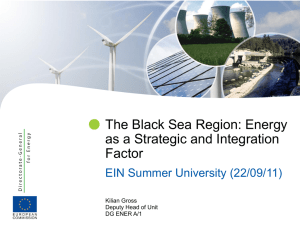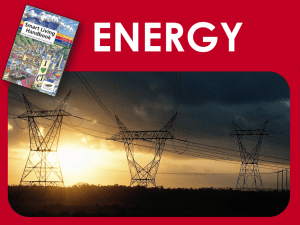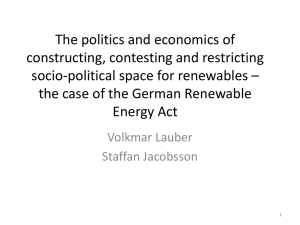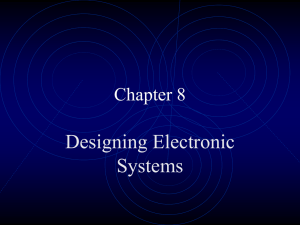Energy basics
advertisement
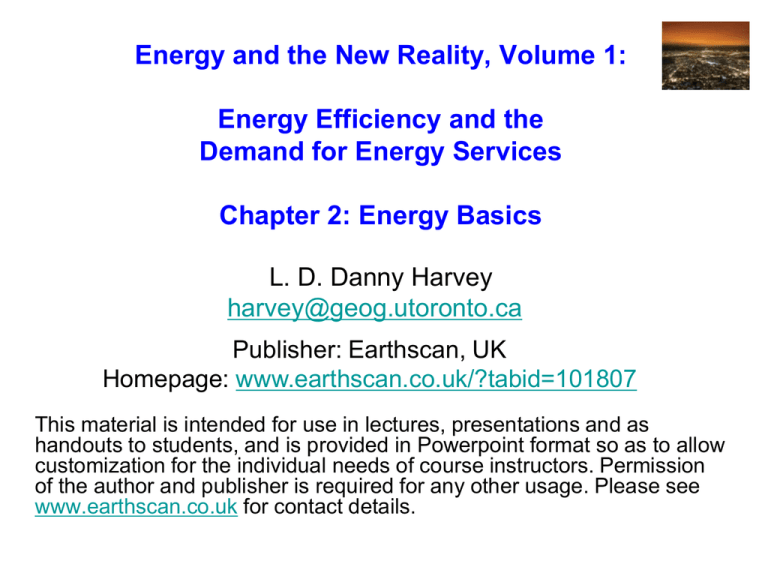
Energy and the New Reality, Volume 1: Energy Efficiency and the Demand for Energy Services Chapter 2: Energy Basics L. D. Danny Harvey harvey@geog.utoronto.ca Publisher: Earthscan, UK Homepage: www.earthscan.co.uk/?tabid=101807 This material is intended for use in lectures, presentations and as handouts to students, and is provided in Powerpoint format so as to allow customization for the individual needs of course instructors. Permission of the author and publisher is required for any other usage. Please see www.earthscan.co.uk for contact details. Forms of energy • Primary energy – as it is found in nature (coal, oil, natural gas in the ground) • Secondary energy – energy that has been converted from primary energy to another form (electricity, refined petroleum products, processed natural gas) • Tertiary energy – one more step in the chain – end-use energy (what we actually want: light, heat, cooling and mechanical power) Conversions: • Secondary energy = primary energy x conversion efficiency • So, given an amount of secondary energy, divide by the conversion efficiency to get the amount of primary energy required to produce that amount of secondary energy Figure 2.1 Primary to Secondary to End-Use Energy Losses P rim a ry E n e rg y Tra n s fo rm a tio n Tra n s p o rta tio n D is trib u tio n Losses S e c o n d a ry E n e rg y U tiliz a tio n F in a l D e v ic e o r U s e fu l S y s te m E n e rg y Primary Energy Equivalent of Electricity from Hydropower or Nuclear Power: • Electricity from hydro and nuclear could instead be produced by burning fossil fuels to generate electricity • So, divide the amount of hydro or nuclear electricity by the efficiency in generating electricity from fossil fuels to get the primary energy equivalent of the hydro or nuclear electricity • I use a standardized efficiency of 40% • Thus, 1 MJ of hydro or nuclear (or wind or solar) electricity is treated here as the equivalent of 2.5 MJ of primary energy Energy and Power • Energy (the ability to do work) has units of joules (J) • Power is the rate of supplying energy, and has units of watts (W), where 1 W = 1 J/s • Thus, to convert power to energy used, we multiply by the length of time in seconds over which the power is supplied, whereas to convert the amount of energy used over a given time to the average power, we divide energy by time in seconds Big Numbers • It is convenient to represent global and regional annual energy use in units of exajoules, where 1 EJ = 1018 joules, and to represent world power demand in gigawatts or terawatts, where 1 GW = 109 watts and 1 TW = 1012 watts, so 1 TW=1000 GW • Primary power (W) demand is given by annual energy use (J) divided by the number of seconds in one year • Thus, total world primary energy use in 2005 of 483 EJ corresponds to an average rate of supply of primary energy (primary power) of 15.3 TW Electrical Energy • When it comes to the energy supplied by an electrical power plant, it is common to multiply the power times the number of hours in the time period during which the power is supplied • Thus, from kW (kilowatts) we get kWh (kilowatt-hours) from GW (gigwatts) we get GWh (gigawatt-hours) from TW (terawatts) we get TWh (terawatt-hours) • To convert energy in units of kWh, GWh or TWh into energy in units involving joules, multiply by the number of seconds in an hour (and divide by the appropriate factor of 10, depending on the desired final units) Figure 2.2a Growth in the Use of Primary Energy 500 Primary Energy Use (EJ/year) 450 400 350 Asia Pacific Africa Middle East FSU Europe S & C America N America +636%, 4.9%/yr 300 +462%, 4.2%/yr +887%, 5.6%/yr 250 200 +68%, 1.3%/yr 150 +91%, 1.6%/yr +385%, 3.9%/yr 100 50 +101%, 1.7%/yr 0 1965 1970 1975 1980 1985 1990 1995 2000 2005 Year Figure 2.2b Growth in the use of primary energy 600 Primary Energy Use (EJ/year) 500 Hydro +227%, 2.9%/yr 400 Nuclear +79%, 2.8%/yr (1985-2006) 300 Coal +109%, 1.8%/yr 200 100 Natural Gas +335%, 3.6%/yr Oil +168%, 2.4%/year 0 1965 1970 1975 1980 1985 1990 1995 2000 2005 Year Figure 2.3 Variation in the price of crude oil, 1860-2008 Price of Crude Oil (US$/barrel) 100 90 80 In money of the day In 2008 US$ 70 60 50 40 30 20 10 0 1860 1910 1960 Year 2010 Figure 2.4 Price of Oil, Natural Gas and Coal 18 Energy Price (US 2008$/GJ) 16 14 12 10 Crude Oil LNG in Japan NG in EU US Henry Hub NG Alberta NG Japan, Imported Coal NW European coal US Appalachian Coal 8 6 4 2 0 1988 1993 1998 Year 2003 2008 Figure 2.5a Growth in Electricity Supply Electricity Generation (TWh/yr) 20000 18000 16000 14000 12000 Asia Pacific Africa Middle East FSU Europe C & S America North America 6.1%/yr 4.0%/yr 10000 6.6%/yr -1.1%/yr 8000 1.8%/yr 6000 4.3%/yr 4000 1.8%/yr 2000 0 1990 1994 1998 Year 2002 2006 Figure 2.5b Growth in Electricity Supply by Energy Source Electricity Generation (TWh/yr) 20000 18000 Overall Increase in Electricity Use, 1990-2006: +60%, 3.0%/yr 16000 1.8%/yr 14000 2.1%/yr 12000 10000 8000 6000 4000 Nuclear Hydro Fossil 3.4%/yr 2000 0 1990 1994 1998 Year 2002 2006 Overview of Energy Supply and Use in 2005 Figure 2.6a World Primary Energy Sources in 2005 Biomass 9.9% Other 0.5% Coal 25.0% Hydro 5.9% Nuclear 5.1% Natural Gas 20.5% Oil 33.2% Total = 483.3 EJ Figure 2.6b OECD Primary Energy Sources in 2005 Biomass 3.5% Other 0.7% Coal 20.2% Hydro 4.7% Nuclear 8.7% Natural Gas 21.9% Oil 40.3% Total = 231.9 EJ Figure 2.6c Non-OECD Primary Energy Sources in 2005 Biomass 15.9% Other 0.3% Coal 29.4% Hydro 6.9% Nuclear 1.8% Natural Gas 19.2% Oil 26.5% Total = 251.4 EJ Figure 2.7a Uses of Coal in 2005 District Heat 3.3% Own Use 1.1% Non-energy & Other 0.3% Buildings 1.4% Industry 14.9% Own Use 3.9% Non-energy & Other 3.1% District Heat 6.8% Buildings 4.0% Electricity Generation 52.5% Industry 29.6% Electricity Generation 79.0% OECD Countries non-OECD Countries Figure 2.7b Uses of Oil in 2005 Non-energy 15.6% Electricity Other Generation 2.2% 4.9% Other 5.4% Non-energy 12.2% Electricity Generation 10.2% Own Use 6.3% Own Use 5.4% District Heat 1.2% District Heat 0.5% Buildings 8.9% Buildings 9.8% Industry 6.2% Transportation Transportation 56.3% OECD Countries Industry 14.9% 39.9% non-OECD Countries Figure 2.7c Uses of Natural Gas in 2005 Non-energy 3.0% Own Use 9.3% Other 0.9% District Heat 4.5% Electricity Generation 26.8% Transportation 0.1% Buildings 34.4% Industry 21.1% OECD Countries Non-energy 8.3% Other 2.0% Own Use 15.4% Electricity Generation 30.8% Transportation 0.6% District Heat 14.4% Buildings 12.9% Industry 15.6% non-OECD Countries Figure 2.8 Direct Primary Energy Use in 2005 Non-specified 0.2% Non-energy use 7.4% Non-energy use 6.3% Residential Buildings 9.2% Non-specified 1.6% Commercial Buildings 4.6% Electricity Generation 38.5% Agriculture 1.2% Electricity Generation 33.2% Residential Buildings 19.1% Commercial Buildings 1.6% Transportation 24.2% District Heating 2.1% Industry 12.5% OECD Countries, Total = 231.9 EJ Agriculture 1.6% Transportation 12.3% District Heating 5.2% Industry 19.3% non-OECD Countries, Total = 251.4 EJ Figure 2.9 Electricity Use By Sector in 2005 Agriculture 0.8% Transport 1.1% Other 1.5% Power Plant 5.5% Distribution 6.5% Commercial 25.2% Industry 32.2% Residential 27.3% OECD Countries, Total = 10392 TWh Other 3.9% Power Plant Agriculture 6.2% 3.9% Transport Distribution 1.8% 11.8% Commercial 10.8% Residential 17.8% Industry 43.9% non-OECD Countries, Total = 7841 TWh Figure 2.10 Primary Energy Use by Sector in 2005 (after allocation of energy used to generate electricity to the sectors that use the electricity) Non-energy 7.5% Agriculture 1.5% Agriculture 3.4% Other 1.8% Industry 26.2% Other 3.3% Non-energy 6.4% Commercial 6.7% Commercial 16.1% Industry 37.8% Residential 28.3% Residential 21.8% Transport 25.0% OECD Countries, Total = 231.9 EJ Transport 14.1% non-OECD Countries, Total = 251.4 EJ Figure 2.11 Annual Electricity Use per capita in 2005 20000 18000 16000 12000 10000 8000 6000 4000 2000 di a In na hi C R us si a y m an G er n Ja pa e an c Fr ia tr al A us U S an a da 0 C kWh/yr/person 14000 Figure 2.12 Distribution of Global Electricity Generating Capacity in 2005 Nuclear 8.9% Wind 1.4% Geothermal 1.5% Hydro 20.3% Thermal 67.8% Total = 4267 GW Figure 2.13 Distribution of Global Electricity Generated by Source in 2005 (IEA data) Wind+Solar 0.7% Geothermal Biomass+Waste 0.3% 1.2% Hydro 16.0% Coal 40.3% Nuclear 15.2% Natural Gas 19.7% Oil 6.5% Total = 18223 TWh Figure 2.14 Geographical Distribution of Electricity Generating Capacity in 2005 Africa 2.6% Oceania 1.5% South America 4.5% Asia 34.1% Europe 27.4% North America 30.0% Total = 4267 GW Energy Resource and Energy Reserves • Energy Resource: in the case of non-renewable energy: how much is there in the ground and potentially extractable • Energy Reserve: that portion of the resources that it is worthwhile extracting given current prices and technology • As technology improves or prices increase, some of the energy in the resource base becomes part of the reserve Figure 2.15 Hypothetical increase in the cost of natural gas in the US with increasing cumulative extraction US$'(88) per barrel of oil equivalent 50 40 No technology advances 30 20 With technology advances 10 0 2 4 6 8 10 12 14 16 18 Gigatonnes of oil equivalent Source: Rogner (1997, Annual Review of Energy and the Environment 22, 217–262)

